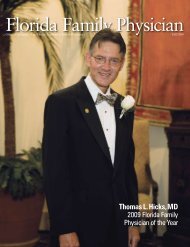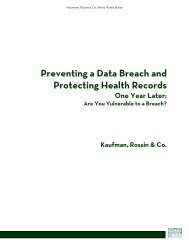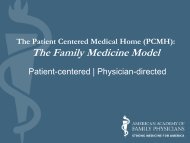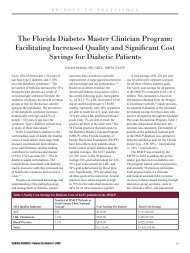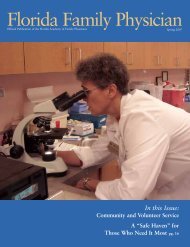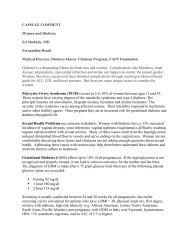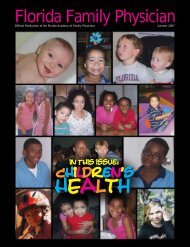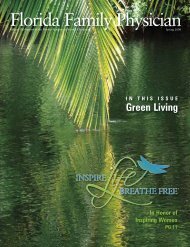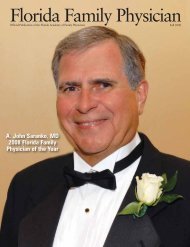ACE/AACE Diabetes Road Maps
ACE/AACE Diabetes Road Maps
ACE/AACE Diabetes Road Maps
- No tags were found...
Create successful ePaper yourself
Turn your PDF publications into a flip-book with our unique Google optimized e-Paper software.
<strong>ACE</strong>/A<strong>ACE</strong> <strong>Diabetes</strong> <strong>Road</strong> <strong>Maps</strong>ROAD MAPS TO ACHIEVE GLYCEMIC CONTROLIN TYPE 2 DIABETES MELLITUS<strong>ACE</strong>/A<strong>ACE</strong> <strong>Diabetes</strong> <strong>Road</strong> Map Task ForceChairpersonsPaul S. Jellinger, MD, M<strong>ACE</strong>Jaime A. Davidson, MD, F<strong>ACE</strong>Task Force MembersLawrence Blonde, MD, FACP, F<strong>ACE</strong>Daniel Einhorn, MD, FACP, F<strong>ACE</strong>George Grunberger, MD, FACP, F<strong>ACE</strong>Yehuda Handelsman, MD, FACP, F<strong>ACE</strong>Richard Hellman, MD, FACP, F<strong>ACE</strong>Harold Lebovitz, MD, F<strong>ACE</strong>Philip Levy, MD, F<strong>ACE</strong>Victor L. Roberts, MD, MBA, FACP, F<strong>ACE</strong>© 2007 A<strong>ACE</strong>.260 ENDOCRINE PRACTICE Vol 13 No. 3 May/June 2007
<strong>ACE</strong>/A<strong>ACE</strong> <strong>Diabetes</strong> <strong>Road</strong> <strong>Maps</strong>ROAD MAPS TO ACHIEVE GLYCEMIC CONTROLIN TYPE 2 DIABETES MELLITUS<strong>ACE</strong>/A<strong>ACE</strong> <strong>Diabetes</strong> <strong>Road</strong> Map Task ForceThe accompanying <strong>Diabetes</strong> <strong>Road</strong> <strong>Maps</strong> were createdto provide direction for clinicians in achieving the hemoglobinA1c (A1C) glycemic goals established by theAmerican College of Endocrinology (<strong>ACE</strong>) and theAmerican Association of Clinical Endocrinologists(A<strong>ACE</strong>). The three <strong>Road</strong> <strong>Maps</strong> consist of the following:one for treatment-naïve patients (Fig. 1), one for treatedpatients not at A1C goal (Fig. 2), and a third focusing onthe prevention of diabetes (Fig. 3). The <strong>Road</strong> <strong>Maps</strong> featureindividualized treatment regimens based on the presentingA1C in treatment-naïve patients or the current A1C intreated patients, and they stress the need to advance therapyif the A1C goal is not met within 3 months. The importanceof targeting the treatment of postprandialhyperglycemia in the lower A1C ranges is emphasized.The following should be noted:1. The evidence base for each of the medications listedin the columns of the <strong>Road</strong> <strong>Maps</strong> can be found in theappended bibliography, and the listed resources areannotated with the levels of evidence. Recommendationsare based on A1C-lowering data from USFood and Drug Administration (FDA)-approvedclinical trials as well as from the large randomizedplacebo- or comparator-controlled clinical trialspublished in peer-reviewed journals, and they areconsistent with FDA-approved indications.2. The relative or rank order of the medications listedin the <strong>Road</strong> <strong>Maps</strong> is derived from valid comparatortrial data that were available. Because of the paucityof such well-designed head-to-head studies, however,the order of medications is provided as a template,is considerably dictated by the preference ofthe authors, and is based on extensive clinical experience.Therefore, the recommended order of interventionscan be categorized primarily as expertopinions of the <strong>Diabetes</strong> <strong>Road</strong> Map Task Force.It is hoped that these <strong>Road</strong> <strong>Maps</strong> will be helpful toclinicians in outlining the therapeutic options currentlyavailable to achieve the optimal level for glycemic control,as proposed by <strong>ACE</strong> and A<strong>ACE</strong>.DISCLOSUREDr. Lawrence Blonde has received grant and/orresearch support from Amylin Pharmaceuticals, Inc.,AstraZeneca, Bristol-Myers Squibb Company, Eli Lillyand Company, MannKind Corporation, Merck & Co.,Inc., Novartis Pharmaceuticals Corporation, NovoNordisk Inc., Pfizer Inc., and sanofi-aventis. He hasreceived speaker and consultant honoraria from AbbottLaboratories, Amylin Pharmaceuticals, Inc.,GlaxoSmithKline, LifeScan, Inc., Eli Lilly and Company,Merck & Co., Inc., Novartis Pharmaceuticals Corporation,Novo Nordisk Inc., Pfizer Inc., and sanofi-aventis. He hasreceived consultant honoraria from KOS Pharmaceuticalsand U.S. Surgical Corporation. Dr. Blonde has also disclosedthat his spouse is a stock shareholder of AmylinPharmaceuticals, Inc. and Pfizer Inc., in an account that isnot part of their community property.Dr. Jaime A. Davidson has received consultant and/orspeaker honoraria from Bristol-Myers Squibb Company,Calixto Medical, CureDM, Inc., Generex BiotechnologyCorporation, GlaxoSmithKline, Johnson & Johnson, EliLilly and Company, Merck Germany, Merck Sharp &Dohme, Novartis Pharmaceuticals Corporation, NovoNordisk Inc., Pfizer Inc., Roche Pharmaceuticals, sanofiaventis,Stein Laboratories, and Takeda PharmaceuticalsAmerica, Inc.Dr. Daniel Einhorn has received clinical research supportfrom Allergan, Inc., Eli Lilly and Company,Medtronic, Inc., Pfizer Inc., and sanofi-aventis. He hasreceived consultant honoraria from AmylinPharmaceuticals, Inc., Eli Lilly and Company, MannKindCorporation, Medtronic, Inc., and Takeda PharmaceuticalsAmerica, Inc. He has received speaker honoraria fromAmylin Pharmaceuticals, Inc., Merck & Co., Inc., sanofiaventis,and Takeda Pharmaceuticals America, Inc.Dr. George Grunberger has received grant/researchsupport from Eli Lilly and Company, Mitsubishi, PfizerInc., and sanofi-aventis. He has received speaker honorariafrom Amylin Pharmaceuticals, Inc., AstraZeneca,GlaxoSmithKline, Eli Lilly and Company, Merck & Co.,Inc., Novo Nordisk Inc., Pfizer Inc., and sanofi-aventis.ENDOCRINE PRACTICE Vol 13 No. 3 May/June 2007 261
Fig. 1. <strong>Road</strong> map to assist clinicians in achieving glycemic goals (established by the American College of Endocrinology and the AmericanAssociation of Clinical Endocrinologists) in treatment-naïve patients with type 2 diabetes. 262 <strong>ACE</strong>/A<strong>ACE</strong> <strong>Diabetes</strong> <strong>Road</strong> <strong>Maps</strong>, Endocr Pract. 2007;13(3)
Fig. 2. <strong>Road</strong> map to assist clinicians in achieving glycemic goals (established by the American College of Endocrinology and the AmericanAssociation of Clinical Endocrinologists) in treated patients with type 2 diabetes not at hemoglobin A1c goal. <strong>ACE</strong>/A<strong>ACE</strong> <strong>Diabetes</strong> <strong>Road</strong> <strong>Maps</strong>, Endocr Pract. 2007;13(3) 263
Fig. 3. <strong>Road</strong> map to assist clinicians in prevention of type 2 diabetes, as recommended by the American College of Endocrinology and theAmerican Association of Clinical Endocrinologists. 264 <strong>ACE</strong>/A<strong>ACE</strong> <strong>Diabetes</strong> <strong>Road</strong> <strong>Maps</strong>, Endocr Pract. 2007;13(3)
<strong>ACE</strong>/A<strong>ACE</strong> <strong>Diabetes</strong> <strong>Road</strong> <strong>Maps</strong>, Endocr Pract. 2007;13(3) 265Dr. Yehuda Handelsman has received speaker honorariafrom Abbott Laboratories, Amylin Pharmaceuticals,Inc., AstraZeneca, Bristol-Myers Squibb Company,GlaxoSmithKline, Novartis Pharmaceuticals Corporation,and sanofi-aventis and consultant honoraria from AbbottLaboratories, GlaxoSmithKline, and sanofi-aventis. Hehas also received grant support for research from sanofiaventis.Dr. Richard Hellman has received speaker honorariafrom Daiichi Sankyo, Inc. and Pfizer Inc. as well asresearch grants from Abbott Laboratories, Medtronic, Inc.,and Pfizer Inc.Dr. Paul S. Jellinger has received speaker honorariafrom GlaxoSmithKline, Merck & Co., Inc., NovartisPharmaceuticals Corporation, Novo Nordisk Inc., andTakeda Pharmaceuticals America, Inc.Dr. Harold Lebovitz has received speaker honorariafrom GlaxoSmithKline and sanofi-aventis. He hasreceived advisory board honoraria from AmylinPharmaceuticals, Inc., LifeScan, Inc., and NovartisPharmaceuticals Corporation. He is a shareholder ofAmylin Pharmaceuticals, Inc., Bristol-Myers SquibbCompany, and sanofi-aventis stocks.Dr. Philip Levy has received speaker honoraria fromAbbott Laboratories, Amylin Pharmaceuticals, Inc.,GlaxoSmithKline, Eli Lilly and Company, Merck & Co.,Inc., Novartis Pharmaceuticals Corporation, NovoNordisk Inc., Pfizer Inc., and sanofi-aventis. He has alsoreceived research grants from Amylin Pharmaceuticals,Inc., GlaxoSmithKline, MannKind Corporation, NovoNordisk Inc., Pfizer Inc., and sanofi-aventis.Dr. Victor L. Roberts has received speaker honorariafrom GlaxoSmithKline, Eli Lilly and Company, Merck &Co., Inc., Novo Nordisk Inc., Pfizer Inc., and sanofi-aventisand has been a speaker for Bristol-Myers SquibbCompany and Takeda Pharmaceuticals America, Inc.BIBLIOGRAPHYGeneral1. American Association of Clinical Endocrinologists PocketGuide to Management of Type 2 <strong>Diabetes</strong>. Version 3.1,2005. (Level 4)2. American College of Endocrinology/AmericanAssociation of Clinical Endocrinologists <strong>Diabetes</strong>Recommendations Implementation WritingCommittee. <strong>ACE</strong>/A<strong>ACE</strong> consensus conference on theimplementation of outpatient management of diabetes mellitus:consensus conference recommendations [positionstatement]. Endocr Pract. 2006;12(Suppl 1):6-12. (Level 4)3. Consensus Statement Writing Committee. AmericanCollege of Endocrinology consensus statement on guidelinesfor glycemic control. Endocr Pract. 2002;8(Suppl1):5-11. (Level 4)Combination Orally Administered Agents1. Bell DS, Ovalle F. Long-term efficacy of triple oral therapyfor type 2 diabetes mellitus. Endocr Pract. 2002;8:271-275. (Level 3)2. Fonseca V, Rosenstock J, Patwardhan R, Salzman A.Effect of metformin and rosiglitazone combination therapyin patients with type 2 diabetes mellitus: a randomized controlledtrial. JAMA. 2000;283:1695-1702. (Level 2)3. Glyburide + metformin (Glucovance) [package insert].Princeton, NJ: Bristol-Myers Squibb Company, 2004. (Notrated)4. Hirschberg Y, Karara AH, Pietri AO, McLeod JF.Improved control of mealtime glucose excursions withcoadministration of nateglinide and metformin. <strong>Diabetes</strong>Care. 2000;23:349-353. (Level 2)5. Moses R, Slobodniuk R, Boyages S, et al. Effect ofrepaglinide addition to metformin monotherapy onglycemic control in patients with type 2 diabetes. <strong>Diabetes</strong>Care. 1999;22:119-124. (Level 1)6. Ovalle F, Bell DS. Triple oral antidiabetic therapy in type2 diabetes mellitus. Endocr Pract. 1998;4:146-147. (Level3)7. Poulsen MK, Henriksen JE, Hother-Nielsen O, Beck-Nielsen H. The combined effect of triple therapy withrosiglitazone, metformin, and insulin aspart in type 2 diabeticpatients. <strong>Diabetes</strong> Care. 2003;26:3273-3279. (Level2)8. Rosiglitazone + glimepiride (Avandaryl) [package insert].Research Triangle Park, NC: GlaxoSmithKline, 2005. (Notrated)9. Rosiglitazone + metformin (Avandamet) [package insert].Research Triangle Park, NC: GlaxoSmithKline, 2005. (Notrated)10. Wolffenbuttel BH, Gomis R, Squatrito S, Jones NP,Patwardhan RN. Addition of low-dose rosiglitazone tosulphonylurea therapy improves glycaemic control in type2 diabetic patients. Diabet Med. 2000;17:40-47. (Level 1)α-Glucosidase Inhibitors1. Acarbose (Precose) [package insert]. West Haven, CT:Bayer Pharmaceuticals, 2004. (Not rated)2. Fischer S, Hanefeld M, Spengler M, Boehme K,Temelkova-Kurktschiev T. European study on doseresponserelationship of acarbose as a first-line drug in noninsulin-dependentdiabetes mellitus: efficacy and safety oflow and high doses. Acta Diabetol. 1998;35:34-40. (Level1)3. Goke B, Herrmann-Rinke C. The evolving role of alphaglucosidaseinhibitors. <strong>Diabetes</strong> Metab Rev. 1998;14(Suppl1):S31-S38. (Level 4)4. Hanefeld M, Fischer S, Schulze J, et al. Therapeuticpotentials of acarbose as first-line drug in NIDDM insufficientlytreated with diet alone. <strong>Diabetes</strong> Care. 1991;14:732-737. (Level 1)5. Miglitol (Glyset) [package insert]. New York, NY: PfizerInc, 2004. (Not rated)6. Santeusanio F, Ventura MM, Contandini S,Compagnucci P, Moriconni V, Zaccarini P. Efficacy andsafety of two different doses of acarbose in non-insulindependentdiabetic patients treated by diet alone. <strong>Diabetes</strong>Nutr Metab. 1993;6:147-154. (Level 2)7. Willms B, Ruge D. Comparison of acarbose and metforminin patients with type 2 diabetes mellitus insufficiently controlledwith diet and sulphonylureas: a randomized, placebo-controlledstudy. Diabet Med. 1999;16:755-761. (Level 2)
266 <strong>ACE</strong>/A<strong>ACE</strong> <strong>Diabetes</strong> <strong>Road</strong> <strong>Maps</strong>, Endocr Pract. 2007;13(3)Incretin Mimetic, Dipeptidyl Peptidase-4 Inhibitors, AmylinAnalogue1. Aschner P, Kipnes MS, Lunceford JK, Sanchez M,Mickel C, Williams-Herman DE (Sitagliptin Study 021Group). Effect of the dipeptidyl peptidase-4 inhibitorsitagliptin as monotherapy on glycemic control in patientswith type 2 diabetes. <strong>Diabetes</strong> Care. 2006;29:2632-2637.(Level 1)2. Buse JB, Henry RR, Han J, Kim DD, Fineman MS,Baron AD (Exenatide-113 Clinical Study Group).Effects of exenatide (exendin-4) on glycemic control over30 weeks in sulfonylurea-treated patients with type 2 diabetes.<strong>Diabetes</strong> Care. 2004;27:2628-2635. (Level 1)3. Charbonnel B, Karasik A, Liu J, Wu M, Meininger G(Sitagliptin Study 020 Group). Efficacy and safety of thedipeptidyl peptidase-4 inhibitor sitagliptin added to ongoingmetformin therapy in patients with type 2 diabetesinadequately controlled with metformin alone. <strong>Diabetes</strong>Care. 2006;29:2638-2643. (Level 1)4. DeFronzo RA, Ratner RE, Han J, Kim DD, FinemanMS, Baron AD. Effects of exenatide (exendin-4) onglycemic control and weight over 30 weeks in metformintreatedpatients with type 2 diabetes. <strong>Diabetes</strong> Care.2005;28:1092-1100. (Level 1)5. Exenatide (Byetta) [package insert]. San Diego, CA:Amylin Pharmaceuticals, 2005. (Not rated)6. Fineman M, Weyer C, Maggs DG, Strobel S,Kolterman OG. The human amylin analog, pramlintide,reduces postprandial hyperglucagonemia in patients withtype 2 diabetes mellitus. Horm Metab Res. 2002;34:504-508. (Level 1)7. Heine RJ, Van Gaal LF, Johns D, Mihm MJ, WidelMH, Brodows RG (GWAA Study Group). Exenatideversus insulin glargine in patients with suboptimally controlledtype 2 diabetes: a randomized trial. Ann Intern Med.2005;143:559-569. (Level 1)8. Hollander P, Ratner R, Fineman M, et al. Addition ofpramlintide to insulin therapy lowers HbA1c in conjunctionwith weight loss in patients with type 2 diabetesapproaching glycaemic targets. <strong>Diabetes</strong> Obes Metab.2003;5:408-414. (Level 1)9. Kendall DM, Riddle MC, Rosenstock J, et al. Effects ofexenatide (exendin-4) on glycemic control over 30 weeksin patients with type 2 diabetes treated with metformin anda sulfonylurea. <strong>Diabetes</strong> Care. 2005;28:1083-1091. (Level1)10. Nauck MA, Meininger G, Sheng D, Terranella L, SteinPP (Sitagliptin Study 024 Group). Efficacy and safety ofthe dipeptidyl peptidase-4 inhibitor, sitagliptin, comparedwith the sulfonylurea, glipizide, in patients with type 2 diabetesinadequately controlled on metformin alone: a randomized,double blind, non-inferiority trial. <strong>Diabetes</strong> ObesMetab. 2007;9:194-205. (Level 1)11. Pramlintide (Symlin) [package insert]. San Diego, CA:Amylin Pharmaceuticals, 2005. (Not rated)12. Ratner RE, Dickey R, Fineman M, et al. Amylin replacementwith pramlintide as an adjunct to insulin therapyimproves long-term glycaemic and weight control in type1 diabetes mellitus: a 1-year, randomized controlled trial.Diabet Med. 2004;21:1204-1212. (Level 1)13. Rosenstock J, Baron MA, Dejager S, Mills D, SchweizerA. Comparison of vildagliptin and rosiglitazone monotherapyin patients with type 2 diabetes: a 24-week, doubleblind,randomized trial. <strong>Diabetes</strong> Care. 2007;30:217-223.(Level 1)14. Rosenstock J, Brazg R, Andryuk PJ, Lu K, Stein P(Sitagliptin Study 019 Group). Efficacy and safety of thedipeptidyl peptidase-4 inhibitor sitagliptin added to ongoingpioglitazone therapy in patients with type 2 diabetes: a24-week, multicenter, randomized, double-blind, placebocontrolled,parallel-group study. Clin Ther. 2006;28:1556-1568. (Level 1)15. Sitagliptin phosphate (Januvia) [package insert]. WestPoint, PA: Merck & Co, Inc, 2006. (Not rated)16. Thompson RG, Gottlieb A, Organ K, Koda J, Kisicki J,Kolterman OG. Pramlintide: a human amylin analoguereduced postprandial plasma glucose, insulin, and C-peptideconcentrations in patients with type 2 diabetes. DiabetMed. 1997;14:547-555. (Level 1)17. Whitehouse F, Kruger DF, Fineman M, et al. A randomizedstudy and open-label extension evaluating thelong-term efficacy of pramlintide as an adjunct to insulintherapy in type 1 diabetes. <strong>Diabetes</strong> Care. 2002;25:724-730. (Level 1)Insulin1. Anderson JH Jr, Brunelle RL, Keohane P, et al(Multicenter Insulin Lispro Study Group). Mealtimetreatment with insulin analog improves postprandial hyperglycemiaand hypoglycemia in patients with non-insulindependentdiabetes mellitus. Arch Intern Med.1997;157:1249-1255. (Level 1)2. DeWitt DE, Hirsch IB. Outpatient insulin therapy in type1 and type 2 diabetes mellitus: scientific review. JAMA.2003;289:2254-2264. (Level 4)3. <strong>Diabetes</strong> Control and Complications Trial ResearchGroup. The effect of intensive treatment of diabetes on thedevelopment and progression of long-term complicationsin insulin-dependent diabetes mellitus. N Engl J Med.1993;329:977-986. (Level 1)4. Hirsch IB, Bergenstal RM, Parkin CG, Wright E Jr,Buse JB. A real-world approach to insulin therapy in primarycare practice. Clin <strong>Diabetes</strong>. 2005;23:78-86. (Level 4)5. Insulin detemir (Levemir) [package insert]. Princeton, NJ:Novo Nordisk, 2005. (Not rated)6. Insulin human (rDNA origin) inhalation powder (Exubera)[package insert]. New York, NY: Pfizer Inc, 2006. (Notrated)7. 50% NPL/50% lispro (lispro mix 50/50) [package insert].Indianapolis, IN: Eli Lilly and Company, 2006. (Not rated)8. Ohkubo Y, Kishikawa H, Araki E, et al. Intensiveinsulin therapy prevents the progression of diabeticmicrovascular complications in Japanese patients withnon-insulin-dependent diabetes mellitus: a randomizedprospective 6-year study. <strong>Diabetes</strong> Res Clin Pract.1995;28:103-117. (Level 1)9. Raskin P, Allen E, Hollander P, et al (INITIATE StudyGroup). Initiating insulin therapy in type 2 diabetes: acomparison of biphasic and basal insulin analogs. <strong>Diabetes</strong>Care. 2005;28:260-265. (Level 1)10. Raskin P, Bode BW, Marks JB, et al. Continuous subcutaneousinsulin infusion and multiple daily injection therapyare equally effective in type 2 diabetes: a randomized,parallel-group, 24-week study. <strong>Diabetes</strong> Care. 2003;26:2598-2603. (Level 2)
<strong>ACE</strong>/A<strong>ACE</strong> <strong>Diabetes</strong> <strong>Road</strong> <strong>Maps</strong>, Endocr Pract. 2007;13(3) 26711. Riddle MC, Rosenstock J, Gerich J (Insulin Glargine4002 Study Investigators). The treat-to-target trial: randomizedaddition of glargine or human NPH insulin to oraltherapy of type 2 diabetic patients. <strong>Diabetes</strong> Care.2003;26:3080-3086. (Level 1)12. Rosenfalck AM, Thorsby P, Kjems L, et al. Improvedpostprandial glycaemic control with insulin aspart in type2 diabetic patients treated with insulin. Acta Diabetol.2000;37:41-46. (Level 2)13. Royle P, Waugh N, McAuley L, McIntyre L, Thomas S.Inhaled insulin in diabetes mellitus. Cochrane DatabaseSyst Rev. 2004;CD003890. (Level 1)14. Schiffrin A, Belmonte M. Multiple daily self-glucosemonitoring: its essential role in long-term glucose controlin insulin-dependent diabetic patients treated with pumpand multiple subcutaneous injections. <strong>Diabetes</strong> Care.1982;5:479-484. (Level 2)15. Writing Team for the <strong>Diabetes</strong> Control andComplications Trial/Epidemiology of <strong>Diabetes</strong>Interventions and Complications Research Group.Effect of intensive therapy on the microvascular complicationsof type 1 diabetes mellitus. JAMA. 2002;287:2563-2569. (Level 1)Insulin Secretagogues1. Glimepiride (Amaryl) [package insert]. Bridgewater, NJ:Sanofi-Aventis U.S., 2005. (Not rated)2. Glipizide (Glucotrol) [package insert]. New York, NY:Pfizer Inc, 2000. (Not rated)3. Glyburide (DiaBeta) [package insert]. Bridgewater, NJ:Sanofi-Aventis U.S., 2004. (Not rated)4. Glyburide (Micronase) [package insert]. New York, NY:Pfizer Inc, 2002. (Not rated)5. Hanefeld M, Bouter KP, Dickinson S, Guitard C. Rapidand short-acting mealtime insulin secretion with nateglinidecontrols both prandial and mean glycemia. <strong>Diabetes</strong>Care. 2000;23:202-207. (Level 1)6. Horton ES, Clinkingbeard C, Gatlin M, Foley J,Mallows S, Shen S. Nateglinide alone and in combinationwith metformin improves glycemic control by reducingmealtime glucose levels in type 2 diabetes. <strong>Diabetes</strong> Care.2000;23:1660-1665. (Level 1)7. Jovanovic L, Dailey G III, Huang WC, Strange P,Goldstein BJ. Repaglinide in type 2 diabetes: a 24-week,fixed-dose efficacy and safety study. J Clin Pharmacol.2000;40:49-57. (Level 1)8. Nateglinide (Starlix) [package insert]. East Hanover, NJ:Novartis Corporation, 2004. (Not rated)9. Nattrass M, Lauritzen T. Review of prandial glucose regulationwith repaglinide: a solution to the problem of hypoglycaemiain the treatment of type 2 diabetes? Int J ObesRelat Metab Disord. 2000;24(Suppl 3):S21-S31. (Level 4)10. Repaglinide (Prandin) [package insert]. Princeton, NJ:Novo Nordisk, 2004. (Not rated)11. Schade DS, Jovanovic L, Schneider J. A placebo-controlled,randomized study of glimepiride in patients withtype 2 diabetes mellitus for whom diet therapy is unsuccessful.J Clin Pharmacol. 1998;38:636-641. (Level 1)12. UK Prospective <strong>Diabetes</strong> Study (UKPDS) Group.Intensive blood-glucose control with sulphonylureas orinsulin compared with conventional treatment and risk ofcomplications in patients with type 2 diabetes (UKPDS 33)[erratum in Lancet. 1999;354:602]. Lancet. 1998;352:837-853. (Level 1)13. Wolffenbuttel BH, Nijst L, Sels JP, Menheere PP,Muller PG, Kruseman AC. Effects of a new oral hypoglycaemicagent, repaglinide, on metabolic control insulphonylurea-treated patients with NIDDM. Eur J ClinPharmacol. 1993;45:113-116. (Level 2)14. Zimmerman BR. Sulfonylureas. Endocrinol Metab ClinNorth Am. 1997;26:511-522. (Level 4)Metformin1. Bailey CJ, Turner RC. Metformin. N Engl J Med.1996;334:574-579. (Level 4)2. DeFronzo RA, Goodman AM (Multicenter MetforminStudy Group). Efficacy of metformin in patients withnon-insulin-dependent diabetes mellitus. N Engl J Med.1995;333:541-549. (Level 1)3. Garber AJ, Duncan TG, Goodman AM, Mills DJ,Rohlf JL. Efficacy of metformin in type II diabetes:results of a double-blind, placebo-controlled, doseresponsetrial. Am J Med. 1997;103:491-497. (Level 1)4. Grant PJ. The effects of high- and medium-dose metformintherapy on cardiovascular risk factors in patientswith type II diabetes. <strong>Diabetes</strong> Care. 1996;19:64-66.(Level 2)5. Hundal RS, Krssak M, Dufour S, et al. Mechanism bywhich metformin reduces glucose production in type 2diabetes. <strong>Diabetes</strong>. 2000;49:2063-2069. (Level 2)6. Johansen K. Efficacy of metformin in the treatment ofNIDDM: meta-analysis. <strong>Diabetes</strong> Care. 1999;22:33-37.(Level 1)7. Metformin (Glucophage) [package insert]. Princeton, NJ:Bristol-Myers Squibb Company, 2003. (Not rated)8. Metformin (Glucophage XR) [package insert]. Princeton,NJ: Bristol-Myers Squibb Company, 2004. (Not rated)9. UK Prospective <strong>Diabetes</strong> Study (UKPDS) Group.Effect of intensive blood-glucose control with metforminon complications in overweight patients with type 2 diabetes(UKPDS 34) [erratum in Lancet. 1998;352:1558].Lancet. 1998;352:854-865. (Level 1)Postprandial Glucose1. Cavalot F, Petrelli A, Traversa M, et al. Postprandialblood glucose is a stronger predictor of cardiovascularevents than fasting blood glucose in type 2 diabetes mellitus,particularly in women: lessons from the San LuigiGonzaga <strong>Diabetes</strong> Study. J Clin Endocrinol Metab.2006;91:813-819. (Level 2)2. Esposito K, Giugliano D, Nappo F, Marfella R.Regression of carotid atherosclerosis by control of postprandialhyperglycemia in type 2 diabetes mellitus.Circulation. 2004;110:214-219. (Level 2)3. Esposito K, Nappo F, Marfella R, et al. Inflammatorycytokine concentrations are acutely increased by hyperglycemiain humans: role of oxidative stress. Circulation.2002;106:2067-2072. (Level 2)4. Hanefeld M, Koehler C, Schaper F, Fuecker K, HenkelE, Temelkova-Kurktschiev T. Postprandial plasma glucoseis an independent risk factor for increased carotid intima-mediathickness in non-diabetic individuals.Atherosclerosis. 1999;144:229-235. (Level 2)
268 <strong>ACE</strong>/A<strong>ACE</strong> <strong>Diabetes</strong> <strong>Road</strong> <strong>Maps</strong>, Endocr Pract. 2007;13(3)5. Marfella R, Quagliaro L, Nappo F, Ceriello A,Giugliano D. Acute hyperglycemia induces an oxidativestress in healthy subjects. J Clin Invest. 2001;108:635-636.(Level 2)6. Monnier L, Collette C, Dunseath GJ, Owens DR. Theloss of postprandial glycemic control precedes stepwisedeterioration of fasting with worsening diabetes. <strong>Diabetes</strong>Care. 2007;30:263-269. (Level 2)7. Monnier L, Lapinski H, Colette C. Contributions of fastingand postprandial plasma glucose increments to theoverall diurnal hyperglycemia of type 2 diabetic patients:variations with increasing levels of HbA(1c). <strong>Diabetes</strong>Care. 2003;26:881-885. (Level 2)Self-Monitoring of Blood Glucose1. Karter AJ, Ackerson LM, Darbinian JA, et al. Selfmonitoringof blood glucose levels and glycemic control:the Northern California Kaiser Permanente <strong>Diabetes</strong> registry.Am J Med. 2001;111:1-9. (Level 3)2. Saudek CD, Derr RL, Kalyani RR. Assessing glycemiain diabetes using self-monitoring blood glucose and hemoglobinA1c. JAMA. 2006;295:1688-1697. (Level 1)3. Schwedes U, Siebolds M, Mertes G (SMBG StudyGroup). Meal-related structured self-monitoring of bloodglucose: effect on diabetes control in non-insulin-treatedtype 2 diabetic patients. <strong>Diabetes</strong> Care. 2002;25:1928-1932. (Level 1)4. Welschen LM, Bloemendal E, Nijpels G, et al. Self-monitoringof blood glucose in patients with type 2 diabeteswho are not using insulin: a systematic review. <strong>Diabetes</strong>Care. 2005;28:1510-1517. (Level 1)Thiazolidinediones1. Aronoff S, Rosenblatt S, Braithwaite S, Egan JW,Mathisen AL, Schneider RL (Pioglitazone 001 StudyGroup). Pioglitazone hydrochloride monotherapyimproves glycemic control in the treatment of patients withtype 2 diabetes: a 6-month randomized placebo-controlleddose-response study. <strong>Diabetes</strong> Care. 2000;23:1605-1611.(Level 1)2. Dormandy JA, Charbonnel B, Eckland DJ, et al(PROactive investigators). Secondary prevention ofmacrovascular events in patients with type 2 diabetes in thePROactive Study (PROspective pioglitAzone ClinicalTrial In macroVascular Events): a randomised controlledtrial. Lancet. 2005;366:1279-1289. (Level 1)3. Einhorn D, Rendell M, Rosenzweig J, Egan JW,Mathisen AL, Schneider RL (Pioglitazone 027 StudyGroup). Pioglitazone hydrochloride in combination withmetformin in the treatment of type 2 diabetes mellitus: arandomized, placebo-controlled study. Clin Ther. 2000;22:1395-1409. (Level 2)4. Gerstein HC, Yusuf S, Bosch J, et al (DREAM[<strong>Diabetes</strong> REduction Assessment with ramipril androsiglitazone Medication] Trial Investigators). Effect ofrosiglitazone on the frequency of diabetes in patients withimpaired glucose tolerance or impaired fasting glucose: arandomised controlled trial [erratum in Lancet.2006;368:1770]. Lancet. 2006;368:1096-1105. (Level 1)5. Kahn SE, Haffner SM, Heise MA, et al (ADOPT StudyGroup). Glycemic durability of rosiglitazone, metformin,or glyburide monotherapy [erratum in N Engl J Med.2007;356:1387-1388]. N Engl J Med. 2006;355:2427-2443. (Level 1)6. Lebovitz HE, Dole JF, Patwardhan R, Rappaport EB,Freed MI (Rosiglitazone Clinical Trials Study Group).Rosiglitazone monotherapy is effective in patients withtype 2 diabetes. J Clin Endocrinol Metab. 2001;86:280-288. (Level 1)7. Mazzone T, Meyer PM, Feinstein SB, et al. Effect ofpioglitazone compared with glimepiride on carotid intimamediathickness in type 2 diabetes: a randomized trial.JAMA. 2006;296:2572-2581. (Level 2)8. Mudaliar S, Henry RR. New oral therapies for type 2 diabetesmellitus: the glitazones or insulin sensitizers. AnnuRev Med. 2001;52:239-257. (Level 4)9. Phillips LS, Grunberger G, Miller E, Patwardhan R,Rappaport EB, Salzman A (Rosiglitazone ClinicalTrials Study Group). Once- and twice-daily dosing withrosiglitazone improves glycemic control in patients withtype 2 diabetes [erratum in <strong>Diabetes</strong> Care. 2001;24:973].<strong>Diabetes</strong> Care. 2001;24:308-315. (Level 1)10. Pioglitazone (Actos) [package insert]. Deerfield, IL:Takeda Pharmaceuticals America, Inc, 2004. (Not rated)11. Pioglitazone + metformin (Actoplus Met) [package insert].Deerfield, IL: Takeda Pharmaceuticals America, Inc, 2005.(Not rated)12. Rosiglitazone (Avandia) [package insert]. ResearchTriangle Park, NC: GlaxoSmithKline, 2005. (Not rated)



